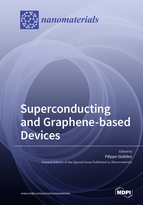Superconducting- and Graphene-based Devices
A special issue of Nanomaterials (ISSN 2079-4991). This special issue belongs to the section "Nanoelectronics, Nanosensors and Devices".
Deadline for manuscript submissions: closed (28 February 2021) | Viewed by 19649
Special Issue Editor
Interests: graphene; 2D materials; electronic properties; field effect transistors; photodetectors; contact resistance; field emission from nanostructures
Special Issues, Collections and Topics in MDPI journals
Special Issue Information
Dear Colleagues,
This Special Issue aims to collect new or improved ideas to exploit superconducting materials, as well as graphene, towards achieving innovative devices, either at a small scale, as well as at a large scale. Several potential applications of graphene are enhanced by the possibility to modify its surface to introduce a non-zero bandgap, to tune adhesion and/or hydrophobicity/hydrophilicity, etc. These surface properties are crucial to the realization of graphene-based devices. Papers demonstrating graphene and/or superconducting devices, device processing, characterization, and applications, are particularly welcomed.
Topics in this Special Issue include, but are not limited to:
- Graphene devices
- Graphene based heterostructures
- Superconducting interfaces
- Superconducting devices
- Electronic, optical, photonic and magnetic properties
- Surface and interfacial characterization techniques
- Device integration and fabrication
Dr. Filippo Giubileo
Guest Editor
Manuscript Submission Information
Manuscripts should be submitted online at www.mdpi.com by registering and logging in to this website. Once you are registered, click here to go to the submission form. Manuscripts can be submitted until the deadline. All submissions that pass pre-check are peer-reviewed. Accepted papers will be published continuously in the journal (as soon as accepted) and will be listed together on the special issue website. Research articles, review articles as well as short communications are invited. For planned papers, a title and short abstract (about 100 words) can be sent to the Editorial Office for announcement on this website.
Submitted manuscripts should not have been published previously, nor be under consideration for publication elsewhere (except conference proceedings papers). All manuscripts are thoroughly refereed through a single-blind peer-review process. A guide for authors and other relevant information for submission of manuscripts is available on the Instructions for Authors page. Nanomaterials is an international peer-reviewed open access semimonthly journal published by MDPI.
Please visit the Instructions for Authors page before submitting a manuscript. The Article Processing Charge (APC) for publication in this open access journal is 2900 CHF (Swiss Francs). Submitted papers should be well formatted and use good English. Authors may use MDPI's English editing service prior to publication or during author revisions.
Keywords
- graphene
- field effect transistors
- field emission
- contact resistance
- photodetectors
- Superconducting devices
- proximity effect
- Andreev reflection
- Josephson junction
- Superconductivity for energy







